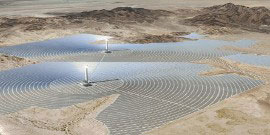Hot on the heels of ARENA’s decision against supporting Alinta’s development of solar thermal power generation in Port Augusta, the federal government has launched an set of online tools, funded by the Australian Renewable Energy Agency, aimed at helping researchers, developers and financiers assess the commercial prospects of Concentrating Solar Thermal power projects in Australia.
Originally developed by the US Department of Energy’s National Renewable Energy Laboratory (NREL), the concentrating solar thermal System Advisor Model (SAM) has been adapted for Australian conditions by the Australian Solar Thermal Energy Association (AUSTELA) through a $73,500 ARENA investment.
According to AUSTELA, the adapted SAM model is “general purpose and can predict hourly, monthly and annual output of CSP, Concentrating PV, flat plate PV and a range of other renewable energy systems” – but there has been an extensive body of work around its application to CSP systems in particular.
“Concentrating solar thermal systems have the potential to play a significant role in future electricity networks as they can store energy, which means clean energy can be dispatched to homes and businesses at anytime of the day or night,” said federal resources and energy minister Gary Gray.
“These new tools – which will optimise an industry-leading United States model for Australian conditions – will make it easier for developers and financiers to assess the commercial viability of concentrating solar thermal projects.”
SAM’s purpose is to provide information to help developers make assess a proposed site’s suitability, the economic performance of the system and the financial viability of the project – the sort of analysis that, as Gary Gray has noted, is “critical to attracting investors” and thus deploying CST technologies in Australia.
But it has arrived a touch too late for Alinta, which announced on Tuesday it had abandoned plans to use concentrating solar thermal technology to complement or replace its ageing coal-fired power stations in Port August, after its application for funding into a feasibility study was rejected by ARENA.
Alinta Energy said it was disappointed by the funding decision – and well it might be, especially in light of ARENA’s announcement, just two weeks ago, of a new investment focus on the development of “hybrid” power plants, where existing fossil fuel power stations would be augmented with renewables.
As RenewEconomy reported in April, Alinta had hoped to spend 12-15 months reviewing technologies that would suit Port Augusta, and possibly hybrid solutions that could be added to the Northern Power Station.
But this marks ARENA’s second rejection of large-scale solar projects in the “steel triangle” of South Australia in recent months, following the decision to pull previously allocated funds to theSolar Oasis project that was to feature the “big dish” technology of Wizard Power. That company is now in voluntary administration and the technology is up for sale.
ARENA cited delays and the inability to meet deadlines as the reason for ending the support for Solar Oasis, and would not not comment on the Alinta case, saying only that the “door remained open” for the power company. “Our programs are open to applications for funding with each project considered on its merits as part of our commitment to making renewable energy technologies more affordable and increasing their supply in Australia,” a spokesperson said.
But while funding for solar thermal remains illusive, the interest is certainly there – at least that’s what Tom Georgis, the senior vice president for development at US-based SolarReserve, toldRenewEconomy earlier this month, regarding the five or six different CST proposals it is currently developing with mining groups.
The Santa Monica-based company is looking at developing a scaled down version of its solar thermal technology – it is currently constructing its 110MW Crescent Dunes solar tower with integrated energy storage near Tonopah in the Nevada desert – to meet the demands of Australian miners located in remote and off-grid locations.
“The interest is there,” said Georgis. “It is an education process, and they are certainly looking to the Nevada project and other projects we are developing.”


